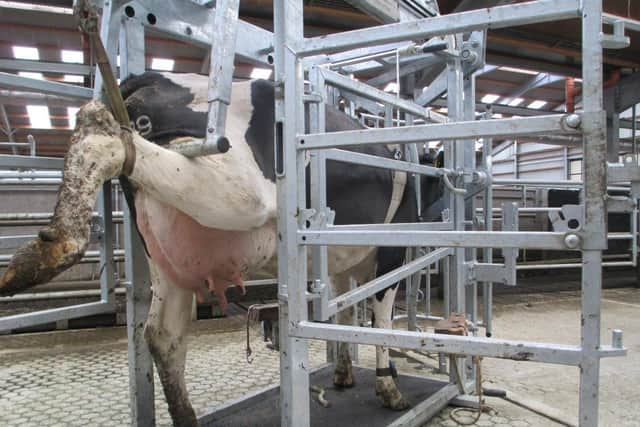Healthy feet means you will have healthy cows


Lameness in dairy cows is a welfare issue as lame cows are likely to be suffering pain.
Lameness also costs money with the average cost of a case of lameness approximately £323, which includes production losses such as cows producing less milk per lactation (200-600 litres), increased time to get in calf (20-40 days) and an increased risk of being culled.
Advertisement
Advertisement
According to Alastair it is critical that a programme, to detect and treat lameness cases promptly, is set up on a dairy farm to reduce the problems associated with lameness.


The first step is detecting lame cows early in lameness development with one such method being mobility scoring, where cows are scored on a scale of 0 to 3 based on their mobility, with 0 being good and 3 being a severely lame cow.
The aim when scoring your herd is to focus on identifying cows scoring 2 (moderately lame), or 3 (severely lame) and prioritize these cows for treatment as soon as possible.
Research has shown that using mobility scoring will reduce the severity of incidences and improve recovery rates among moderately lame cows when they are detected early and treated as soon as possible.
Advertisement
Advertisement
It is important to remember that generally cows don’t go from being not lame (score 0-1), to severely lame (score 3) immediately, they will be moderately lame (mobility score 2) for a period of time.
This allows you to take action before any further deterioration occurs.
The CAFRE dairy herd is mobility scored once per month.
Following this, any cows with a score of two or above are scheduled for foot trimming/examination ASAP. To date the CAFRE dairy herd has an average herd mobility index of 92% which is the percentage of the herd not lame. Additional to the monthly visual mobility scoring, two automated lameness detection systems have been integrated within the herd to identify individual cows and their locomotion score. Data from the systems will be used to evaluate locomotion within the CAFRE dairy herd over the next few months.
Alastair summarises the key strategies necessary to manage lameness with an emphasis on prevention:
r Early detection and prompt treatment
Advertisement
Advertisement
r Identify lame cows via mobility scoring using whatever means
r Promptly treat score 2 cows before they are severely lame
r Record the cow number, date and hoof disease diagnosed/treated
r Follow up treatments if required
Prevention
r Use preventative foot trimming at key times during lactation
r Footbath the entire herd regularly, including dry cows
r Ensure good cow comfort and hygiene within cow buildings with non-slip flooring, no sharp edges etc.
Advertisement
Advertisement
r Maintain cow lanes to grazing paddocks, well compacted, with no sharp stones.
Discuss the benefits of implementing an effective lameness management programme in your dairy herd with the local CAFRE Dairy Development Adviser.